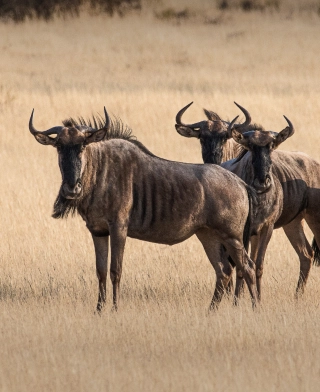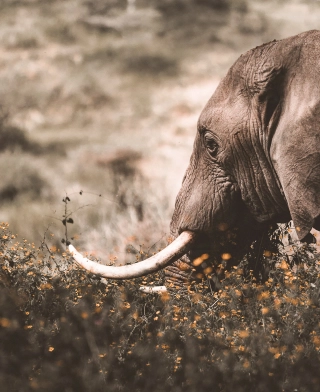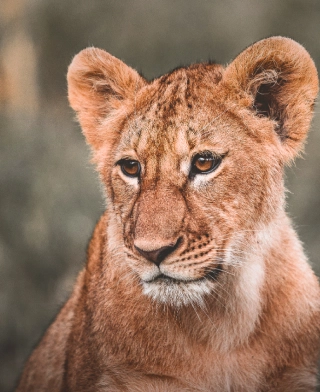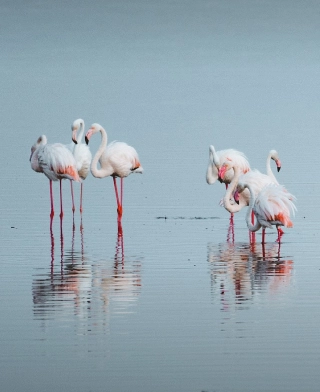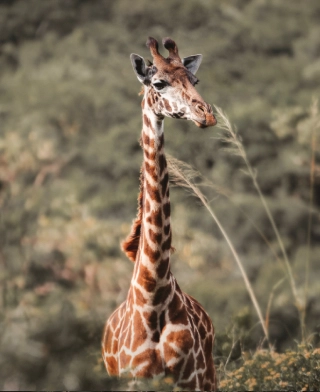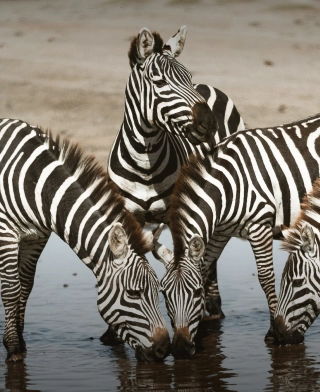Seremara Safaris
Kenya Travel Guide
Kenya Travel Guide, Your Ultimate Resource to Exploring Kenya.
Seremara Safaris
Kenya Travel Guide
Kenya stands as one of Africa’s premier safari destinations, offering travelers an unparalleled combination of wildlife viewing opportunities, diverse landscapes, and rich cultural experiences. As part of an East African safari, this nation provides visitors with the chance to witness the iconic Big Five in their natural habitat, experience the breathtaking Great Migration, and engage with traditional communities while enjoying accommodations ranging from rustic to luxurious. Safety concerns are manageable with proper preparation, and the country’s well-developed tourism infrastructure makes it accessible to various types of travelers. This comprehensive guide covers essential information for planning an unforgettable Kenyan Safari adventure, from optimal timing and wildlife viewing to practical considerations like health precautions and transportation options.
Here the Seremara Safaris detailed Kenya Safari Guide helps you navigate the amazing wildlife of Kenya national parks and enjoy the unparalleled Kenya Safari Tours.
Best Time to Visit Kenya
The timing of your Kenya visit significantly impacts your safari experience and should be carefully considered based on your travel objectives. The Dry Season, spanning from June through October, offers optimal wildlife viewing conditions across Kenya’s diverse national parks and reserves. During these months, vegetation thins out, making wildlife more visible as they congregate around diminishing water sources. The reduced foliage provides clearer sightlines for photography, while the typically dry weather ensures more reliable road conditions for game drives. These factors combine to make this period the high season for Kenyan safaris, with correspondingly higher accommodation rates and more visitors at popular destinations. Additionally, the cost of Kenya safari packages can vary significantly during this season, with higher prices for private and luxury options compared to group and basic packages.
In contrast, the Rainy Seasons, which occur from November to December (short rains) and March to May (long rains), present an entirely different safari experience1. The landscape transforms dramatically as the parched savanna gives way to lush, vibrant greenery, creating spectacular backdrops for photography. These seasons coincide with unique wildlife behaviors, including calving periods for many species, which increases predator activity. Birdwatching enthusiasts particularly appreciate the rainy seasons when migratory species arrive, adding to Kenya’s already impressive avian diversity. An additional benefit of traveling during these periods is the significantly reduced tourist numbers, allowing for a more intimate safari experience often at lower prices. The cost of Kenya safari tours also varies during these seasons, with budget options becoming more affordable and luxury experiences offering more competitive rates.
Climate variations across Kenya’s diverse regions should also factor into your decision-making process. Coastal areas like Mombasa and Malindi experience higher humidity year-round, while highland regions including Nairobi enjoy more moderate temperatures. The great plains of the Maasai Mara can experience dramatic temperature fluctuations between day and night, particularly during the dry season. Understanding these regional differences allows travelers to pack appropriately and select accommodations with suitable amenities for their comfort throughout their journey across Kenya’s varied landscapes.
Accommodation in Kenya
Kenya provides an impressive spectrum of accommodation options, including luxury safari lodges, that cater to varying preferences, budgets, and desired levels of immersion in the wilderness experience. Luxury lodges represent the premium segment of Kenya’s safari accommodations, offering elegant architecture, gourmet dining, spa facilities, and exceptional service in remarkable settings. These establishments typically feature spacious suites with private verandas overlooking waterholes or sweeping savanna vistas, allowing guests to observe wildlife without leaving their accommodations. Interior designs often blend contemporary luxury with traditional African aesthetics, creating sophisticated spaces that remain connected to their natural and cultural context. While these lodges command premium prices, they deliver unforgettable experiences through their combination of wilderness immersion and refined comfort.
Tented camps provide a more authentic bush experience while still offering considerable comfort. The term “tented” can be somewhat misleading, as many of these accommodations feature permanent structures with canvas walls and roofs, proper beds, en-suite bathrooms, and surprisingly elegant furnishings. The canvas elements create a more intimate connection with the surrounding environment, allowing guests to hear nighttime calls of hyenas, lions, and nocturnal birds from the comfort of their beds. Many tented camps operate on a seasonal basis, particularly in areas like the northern Maasai Mara where they follow the migration patterns, minimizing their environmental footprint while maximizing wildlife viewing opportunities. The communal dining experiences offered at many tented camps foster camaraderie among guests, creating opportunities to share the day’s sightings and photography tips in convivial settings.
Family-friendly accommodations address the specific needs of multigenerational travelers, offering interconnected rooms or family tents that keep parents and children together while providing adequate space and privacy. These properties typically offer specialized programs for younger visitors, including junior ranger activities, guided nature walks appropriate for children, and modified game drives with earlier return times. Child-friendly dining options accommodate selective eaters while still introducing children to local flavors in approachable ways. The best family-oriented properties balance educational opportunities with fun activities, helping children develop appreciation for wildlife conservation while creating shared family memories. When traveling with children, it’s essential to verify age policies in advance, as some properties maintain minimum age requirements or restrictions for certain activities like walking safaris, where quiet and careful movement is essential.
Best Places to Visit in Kenya
Kenya stands as a pillar of African wildlife conservation, home to some of the world’s most renowned national parks and reserves that showcase nature’s grandeur in its purest form. From the endless plains of the Maasai Mara to the elephant herds of Amboseli framed by Mount Kilimanjaro, the country offers unparalleled safari experiences across diverse ecosystems. These protected areas not only preserve critical habitats for endangered species but also support sustainable tourism models that benefit local communities. Kenya’s conservation success reflects decades of evolving approaches to wildlife management, with innovative public-private partnerships creating new models for biodiversity protection. The following exploration details Kenya’s most exceptional wildlife destinations, each offering distinctive landscapes, unique wildlife populations, and unforgettable safari experiences that continue to draw nature enthusiasts from around the globe.
Maasai Mara National Reserve
The Maasai Mara National Reserve stands as the crown jewel of Kenya’s wildlife sanctuaries, earning its reputation as one of Africa’s most spectacular safari destinations. This expansive savannah ecosystem in southwestern Kenya covers approximately 1,510 square kilometers of rolling grasslands and acacia woodlands, providing the perfect backdrop for extraordinary wildlife encounters. The reserve’s open plains host an astonishing density of predators and prey, creating a dynamic ecosystem where the drama of nature unfolds before visitors daily. Professional guides frequently describe the Mara as offering some of the most reliable big cat sightings on the continent, with multiple lion prides, cheetahs hunting across open grasslands, and elusive leopards concealed among riverside forests.
The Maasai Mara achieves global recognition for hosting the northern portion of the Great Migration, arguably nature’s most spectacular wildlife event. Between July and October annually, millions of wildebeest and hundreds of thousands of zebras traverse the Serengeti-Mara ecosystem in pursuit of fresh grazing, culminating in dramatic river crossings where crocodiles await the herds at the Mara River. These crossings represent nature at its most raw and unfiltered—a life-and-death struggle where predators capitalize on prey vulnerability in a primal display of survival. Beyond the migration period, the Mara maintains excellent year-round wildlife viewing opportunities with resident populations of the “Big Five” (lion, leopard, elephant, buffalo, and rhino, though rhinos are rare), alongside numerous other species including giraffes, hippos, and over 470 bird species.
The cultural dimension of the Maasai Mara enhances its appeal as a wildlife destination. The reserve takes its name from the Maasai people who have traditionally inhabited these lands, maintaining their distinctive culture and traditional pastoral lifestyle. Many safari itineraries incorporate visits to authentic Maasai villages where travelers can engage with community members, learn about traditional practices, and understand the evolving relationship between conservation and indigenous cultures. This cultural interaction adds depth to the wildlife experience, providing context for how human communities have coexisted with wildlife across generations. The Maasai Mara exemplifies Kenya’s approach to community-based conservation, with numerous conservancies surrounding the main reserve where local landowners participate directly in wildlife protection while deriving economic benefits from sustainable tourism.
Amboseli National Park
Amboseli National Park creates one of Africa’s most iconic landscapes through its striking combination of diverse wildlife against the backdrop of Mount Kilimanjaro’s snow-capped peak. Though relatively modest in size at 392 square kilometers, the park compensates with extraordinary density and visibility of wildlife, particularly its renowned elephant populations. These magnificent creatures, often numbering in herds of hundreds, have been studied for decades by researchers documenting their complex social structures and behaviors. The park’s flat, open terrain provides unobstructed views that make Amboseli a photographer’s paradise, with the juxtaposition of Africa’s tallest mountain and its largest terrestrial mammals creating breathtaking compositions that have graced countless wildlife publications and travel brochures.
The park’s ecosystem derives its character from a unique hydrological system. While appearing largely arid, Amboseli features natural springs and swamps fed by underground water from Kilimanjaro’s melting snow, creating green oases that attract and sustain diverse wildlife. These wetlands support not only elephants but also buffaloes, hippos, and numerous waterbirds, while the surrounding savannah hosts predators including lions, cheetahs, and hyenas. Amboseli’s contrasting habitats of dusty plains and lush swampland create ecological niches for over 400 bird species, making it a premier destination for ornithologists and casual birdwatchers alike.
Originally designated as the “Southern Reserve” for the Maasai in 1906, Amboseli achieved national park status in 1974 and UNESCO Biosphere Reserve recognition in 1991, highlighting its global ecological significance. The park exemplifies both conservation challenges and successes, having experienced periods of elephant population decline followed by recovery through enhanced protection measures. Today, Amboseli’s management model increasingly involves local Maasai communities in conservation decisions, recognizing their traditional knowledge and creating economic incentives for wildlife protection through tourism revenue sharing. The best viewing experiences occur during the dry season from June through October when animals congregate around water sources and vegetation thins, though the park offers excellent wildlife encounters year-round.
Lewa Wildlife Conservancy
The Lewa Wildlife Conservancy represents one of Africa’s most inspiring conservation success stories, evolving from a cattle ranch established in the 1920s to a globally recognized model for sustainable wildlife protection. Spanning 62,000 acres of diverse habitat at the foothills of Mount Kenya, Lewa demonstrates how private lands can make extraordinary contributions to biodiversity conservation when managed with vision and commitment. The conservancy’s transformation began in 1983 when the Craig family set aside 5,000 acres as a sanctuary for critically endangered black rhinos whose population had plummeted to fewer than 300 individuals across Kenya due to rampant poaching. This initiative proved so successful that by 1995, the family dedicated their entire ranch to conservation, creating what has become a sanctuary for approximately 14% of Kenya’s rhino population.
Lewa’s approach to conservation extends far beyond protected area management, embracing a holistic model that integrates wildlife protection with community development. The conservancy invests significantly in neighboring communities through initiatives spanning education, healthcare, water infrastructure, micro-enterprise development, and youth empowerment. These programs have built strong relationships with local residents, creating a constituency that values and supports conservation efforts rather than seeing wildlife as competition for resources. By 2020, Lewa’s community programs had provided affordable healthcare to nearly 50,000 people, implemented clean water projects, distributed 1,800 microloans primarily to women entrepreneurs, and reached over 7,700 students and teachers annually through educational initiatives.
The conservancy offers exceptional wildlife viewing opportunities across its varied landscape of plains, rolling hills, swamps, and forests. Beyond its famous rhino population, Lewa protects the full complement of the “Big Five” alongside rare northern species including the endangered Grevy’s zebra, of which 90% of the wild population can be found at Lewa and surrounding areas. The conservancy also provides critical habitat for reticulated giraffes, wild dogs, and over 400 migratory elephants that traverse the region during seasonal movements. A remarkable conservation innovation is the 14-kilometer elephant corridor connecting Lewa with Mount Kenya National Park through the Ngare Ngare Forest Reserve, allowing free movement of elephants between these protected areas while reducing human-wildlife conflict and enhancing genetic diversity. This dedication to innovative conservation solutions has earned Lewa designation as part of the UNESCO Mount Kenya World Heritage Site.
Samburu National Reserve
Samburu National Reserve offers visitors an authentic wilderness experience in Kenya’s semi-arid northern frontier, where distinctive wildlife adaptations and dramatic landscapes create a safari experience markedly different from the country’s southern parks. Located along the life-giving Ewaso Nyiro River, this 165-square-kilometer reserve forms the centerpiece of a conservation complex that includes the adjacent Buffalo Springs and Shaba National Reserves. The river creates a verdant ribbon through an otherwise harsh landscape, attracting diverse wildlife and serving as the ecological backbone of the entire region. This geographical positioning gives Samburu its distinctive character as a transition zone between Kenya’s lush highlands and the more arid northern territories.
What truly distinguishes Samburu is its population of northern specialist species collectively known as the “Samburu Special Five”—animals adapted to thrive in more arid conditions than their southern counterparts. These include the elegant reticulated giraffe with its geometric patterned coat, the endangered Grevy’s zebra with narrower stripes than the more common plains zebra, the long-necked gerenuk antelope often seen standing on hind legs to browse high foliage, the statuesque beisa oryx with its rapier-like horns, and the blue-legged Somali ostrich. Beyond these specialties, the reserve supports healthy populations of elephants, lions, leopards, cheetahs, and various antelope species. The river environment provides habitat for crocodiles and draws numerous bird species, contributing to Samburu’s reputation as an excellent birdwatching destination.
The cultural dimension of Samburu adds another layer of richness to the visitor experience. The reserve takes its name from the Samburu people, relatives of the Maasai who maintain traditional semi-nomadic lifestyles herding cattle, goats, and camels in the surrounding region. Many local Samburu work within the reserve as guides and rangers, bringing invaluable ecological knowledge and tracking skills that enhance wildlife viewing opportunities. The reserve’s relative remoteness has preserved its authenticity, allowing it to escape the higher visitor numbers experienced in more accessible parks. This creates a more intimate safari experience where encounters with other vehicles remain limited, particularly in the early morning and late afternoon when wildlife activity peaks.
Lake Nakuru National Park
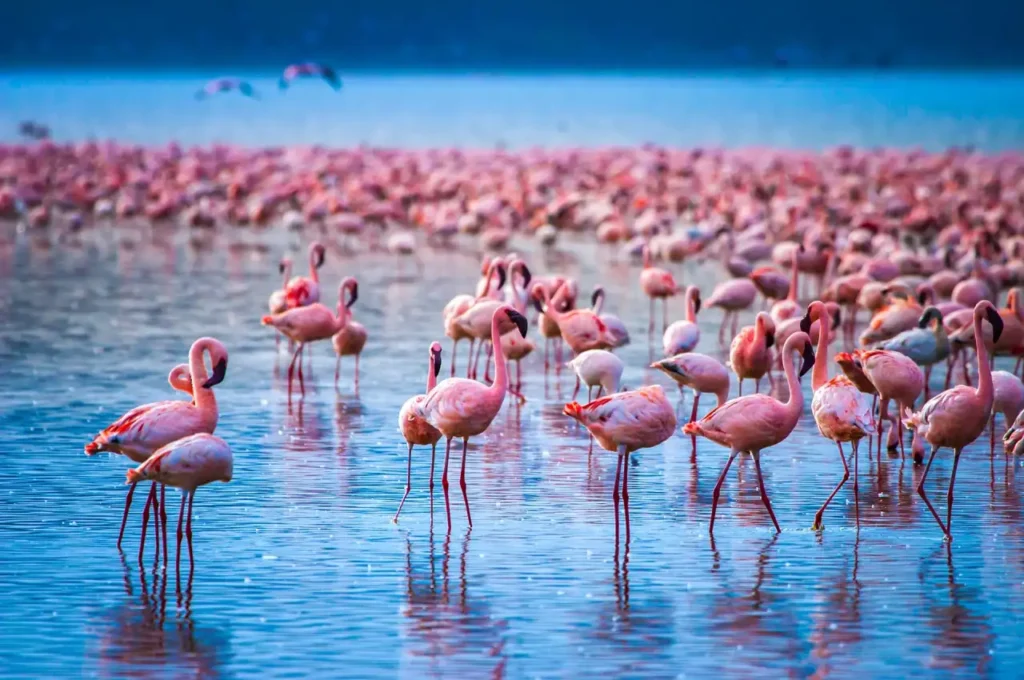
Lake Nakuru National Park presents a captivating combination of spectacular birdlife, diverse mammals, and scenic landscapes within its compact 188-square-kilometer area in Kenya’s Great Rift Valley. The park’s centerpiece, Lake Nakuru itself, has achieved global fame for the extraordinary flamingo congregations that historically lined its shores in numbers reaching up to 1.5 million birds, creating a mesmerizing pink fringe visible from considerable distances. While flamingo numbers fluctuate with changing water conditions and have decreased in recent years due to environmental factors, the lake remains an important habitat for these birds alongside numerous other waterfowl and wading species that contribute to the park’s designation as an Important Bird Area with over 300 avian species recorded.
Beyond its ornithological significance, Lake Nakuru has emerged as a vital sanctuary for rhinoceros conservation. Declared a rhino sanctuary in 1983, the park now protects substantial populations of both critically endangered black rhinos and the more numerous white rhinos within its boundaries. The fenced nature of the park provides enhanced security for these threatened pachyderms, making Nakuru one of the most reliable locations in Kenya for rhino sightings. The mammalian diversity extends well beyond rhinos to include lions (sometimes seen resting in trees in the southern sector), leopards, zebras, giraffes, warthogs, baboons, and numerous antelope species including waterbuck that thrive in the varied habitats ranging from lakeshore to woodland and rocky hillsides.
The distinctive landscape of Lake Nakuru National Park encompasses not only the alkaline lake but also surrounding acacia woodlands, grasslands, and the dramatic backdrop of the Rift Valley escarpment. This topographical variety creates multiple ecological niches supporting diverse wildlife while offering visitors stunning scenic vistas. The elevated viewpoints provide panoramic perspectives across the entire park, revealing the lake’s changing hues influenced by algal populations and flamingo concentrations. The park’s relatively small size and proximity to Nairobi (approximately 140 kilometers northwest of the capital) make it accessible for both extended visits and day trips, contributing to its popularity among both international visitors and Kenyan residents seeking wildlife experiences within limited timeframes.
Tsavo National Parks: East and West
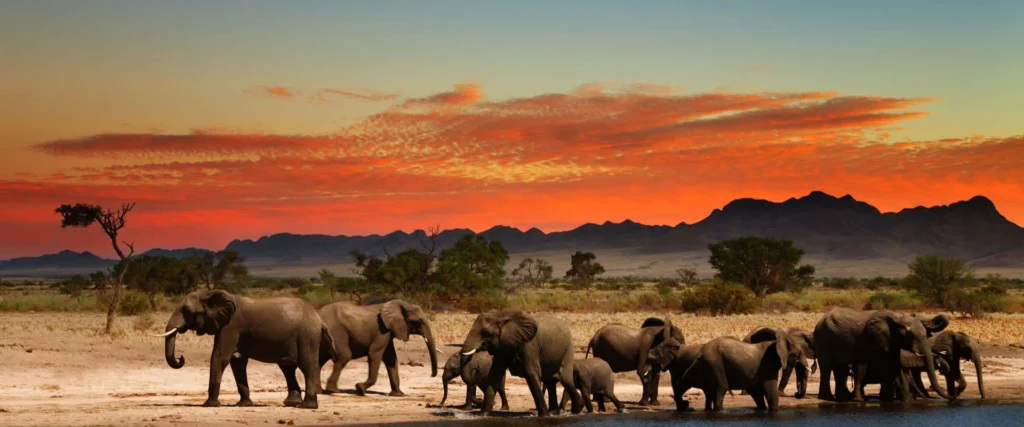
The Tsavo National Parks represent Kenya’s largest protected wilderness area, spanning an immense 22,000 square kilometers and divided into two distinct sections—Tsavo East and Tsavo West—each with unique landscapes and wildlife populations. Established in 1948, Tsavo holds historical significance as one of Kenya’s oldest conservation areas and played a crucial role in early wildlife protection efforts. The sheer scale of these parks, comparable to the size of small countries, provides spatial requirements for wide-ranging species and maintains ecological processes across vast landscapes. This expansiveness creates a wilderness experience distinct from smaller, more concentrated reserves, with Tsavo offering an authentic sense of Africa’s boundless natural heritage.
Tsavo East, characterized by flat, arid plains and the life-giving presence of the Galana River, creates iconic safari scenery where visibility extends for miles across open savannah. The park gained fame for its “red elephants”—pachyderms covered in the distinctive rust-colored soil they dust themselves with for protection against insects and the harsh sun. Beyond elephants, the eastern section supports diverse ungulates including buffalo, various antelope species, zebras, and giraffes, alongside predators such as lions, leopards, and cheetahs. The flatter terrain makes wildlife spotting more straightforward during dry seasons when animals concentrate around permanent water sources.
Tsavo West presents a dramatically different landscape with volcanic hills, springs, and lush oases creating more varied topography than its eastern counterpart. The park features several remarkable landmarks including Mzima Springs—crystal-clear natural springs producing 250 million liters of water daily and supporting hippos, crocodiles, and various fish visible through an underwater viewing chamber. The more rugged terrain harbors similar wildlife to Tsavo East but requires more patient searching, with dense vegetation providing excellent habitat for leopards and smaller forest-dwelling species. Both sections of Tsavo remain less visited than Kenya’s northern parks despite their extraordinary biodiversity, offering visitors seeking a more secluded safari experience the opportunity to explore vast wilderness areas with fewer encounters with other vehicles.
Meru National Park: A Wilderness Reborn
Meru National Park represents one of Kenya’s most impressive conservation recovery stories, having been restored from near-devastation to a thriving wildlife haven. Located east of Mount Kenya, this 870-square-kilometer protected area suffered catastrophic poaching during the 1980s and early 1990s that decimated wildlife populations and tourism. Through dedicated conservation efforts, enhanced security measures, and wildlife reintroductions, Meru has experienced a remarkable renaissance that makes it increasingly attractive for visitors seeking authentic wilderness experiences away from more crowded destinations. The park holds historical significance as the setting for Joy Adamson’s book “Born Free” and the conservation work of George and Joy Adamson with lions, particularly the famous lioness Elsa.
The landscape of Meru creates distinctive safari environments through its combination of open grasslands, riverine forests, and doum palm groves alongside thirteen rivers and numerous streams that provide essential water sources for wildlife. This hydrological abundance creates green corridors through otherwise dry surroundings, attracting diverse species and enabling year-round wildlife viewing opportunities. The rivers themselves host substantial hippo and crocodile populations, while riparian forests provide ideal habitat for leopards. The varied terrain supports impressive biodiversity including the “Big Five” (lion, leopard, elephant, buffalo, and rhino), with rhinos protected within a dedicated sanctuary inside the park. Cheetahs, giraffes, and numerous antelope species including the distinctive oryx and lesser kudu further enhance the park’s wildlife appeal.
Despite its ecological restoration and excellent wildlife viewing opportunities, Meru remains one of Kenya’s less-visited major parks, creating a compelling option for travelers seeking wilderness immersion without the vehicle concentrations sometimes experienced in more popular destinations. This relative seclusion offers a more intimate connection with nature, where visitors might find themselves alone at spectacular wildlife sightings that would attract dozens of vehicles elsewhere. The reduced human presence enhances opportunities for authentic wildlife behavior observation while creating a sense of discovery reminiscent of earlier eras of African exploration. As awareness of Meru’s recovery grows, the park increasingly attracts conservation-minded visitors seeking to support rehabilitation success stories through their tourism choices.
The Laikipia Plateau: A Conservation Success Story
The Laikipia Plateau represents one of Kenya’s most innovative conservation landscapes, where former cattle ranches have transformed into a mosaic of private and community conservancies that collectively protect approximately 9,500 square kilometers of diverse habitat. This high-elevation region northwest of Mount Kenya has pioneered new models of conservation that integrate wildlife protection with sustainable cattle ranching, community development, and responsible tourism. The plateau’s conservation significance extends beyond its boundaries, with Laikipia supporting more endangered mammals than anywhere else in East Africa and serving as a critical refuge for species facing habitat loss elsewhere. Among its most remarkable achievements is providing sanctuary for approximately 50% of Kenya’s entire rhino population, making it a cornerstone of efforts to save these threatened pachyderms.
Laikipia distinguishes itself through the extraordinary diversity of safari experiences available across its various conservancies. Unlike government-managed parks with standardized regulations, each Laikipia conservancy develops its own approach to visitor experiences, creating unprecedented variety. Some properties specialize in walking safaris led by armed guides who interpret tracking signs and smaller ecosystem components often missed from vehicles. Others have developed horseback safaris that allow closer approaches to wildlife accustomed to equestrian presence. Night drives, prohibited in national parks, are permitted throughout Laikipia, offering opportunities to observe nocturnal species rarely seen in traditional safari destinations. The privately managed nature of these conservancies enables flexibility in activities that enhances visitor engagement with the natural environment.
Several individual conservancies within Laikipia have achieved international recognition for their conservation accomplishments. Lewa Wildlife Conservancy (discussed separately) anchors the eastern portion of the plateau with its renowned rhino protection programs. Ol Pejeta Conservancy further west protects the world’s last two northern white rhinos alongside successful populations of black and southern white rhinos. Borana Conservancy has pioneered the reintroduction of rhinos to historical ranges where they were previously extirpated by poaching. The Loisaba Conservancy combines wildlife conservation with cutting-edge research on predator ecology and human-wildlife conflict mitigation. Collectively, these and other conservancies demonstrate how privately managed lands can make extraordinary contributions to biodiversity conservation while creating economic opportunities for surrounding communities through tourism employment, supply chain participation, and direct benefit-sharing mechanisms.
Conservation Beyond Parks: Community Conservancies
Kenya’s wildlife conservation landscape has evolved significantly beyond the traditional model of government-managed national parks to embrace community conservancies that expand protected areas while creating direct benefits for local residents. These community-owned and managed lands now form critical buffers around national parks and establish wildlife corridors between protected areas, significantly expanding the effective conservation footprint across Kenya. The northern regions particularly exemplify this approach, with dozens of community conservancies surrounding core protected areas in Samburu, Laikipia, and beyond. These locally-governed conservation areas represent a fundamental shift in wildlife management philosophy, recognizing that long-term conservation success depends on local communities perceiving tangible economic and social benefits from protecting rather than exploiting wildlife.
The conservancy model addresses historical tensions between protected areas and surrounding communities by directly connecting conservation with livelihood improvement. Through partnerships with safari operators and conservation organizations, communities receive lease payments for dedicating land to wildlife, employment opportunities in tourism and conservation sectors, and revenue-sharing from visitor fees. This economic foundation creates incentives for wildlife protection while fostering community ownership of conservation outcomes. The Mara Naboisho and Mara North Conservancies adjacent to the Maasai Mara National Reserve exemplify this approach, where Maasai landowners receive guaranteed income regardless of tourism fluctuations while maintaining limited grazing rights that recognize traditional land use patterns. These arrangements have dramatically increased land under conservation management while improving local economic security.
Beyond economic benefits, community conservancies significantly enhance the game viewing experience through reduced vehicle density and expanded activity options. Unlike national parks with standardized regulations, conservancies typically limit bed numbers and vehicle access, creating more exclusive wildlife viewing with fewer disturbances. Many conservancies permit activities prohibited in national parks, including night drives to observe nocturnal species, guided bush walks that provide intimate ground-level perspectives on ecosystems, and cultural interactions with community members. The growing network of over 160 community conservancies across Kenya represents one of Africa’s most promising conservation developments, creating a more inclusive model that recognizes local stewardship as essential for biodiversity protection while expanding pristine wildlife habitat beyond traditional park boundaries.
Exploring Kenya's Wildlife: Kenya Safari Tours
Kenya’s reputation as a premier wildlife destination is well-earned, with the country serving as home to the legendary Big Five: lions, elephants, buffaloes, leopards, and rhinoceroses2. These iconic species represent just the beginning of Kenya’s remarkable biodiversity, which includes cheetahs racing across the savanna, towering giraffes browsing acacia trees, vast zebra herds, and an astonishing array of bird species that delight both casual observers and dedicated ornithologists. The concentration and diversity of wildlife make Kenya an unparalleled destination for nature enthusiasts seeking authentic encounters with Africa’s most celebrated animal species.
The Maasai Mara National Reserve stands as Kenya’s wildlife crown jewel, particularly famous for its abundant wildlife including exceptional big cat populations and role in the Great Migration. Visitors to this expansive ecosystem regularly witness pride of lions lounging in the golden grass, leopards draped across acacia branches, and cheetahs scanning the horizon from termite mounds. Meanwhile, Amboseli National Park, Tsavo East and Tsavo west national parks offers perhaps the most iconic African vista: herds of elephants roaming beneath the snow-capped silhouette of Mount Kilimanjaro. The park’s relatively flat, open landscape facilitates exceptional wildlife viewing, with large elephant populations that have been studied for decades by researchers documenting their complex social structures.
For travelers seeking more specialized wildlife experiences, Kenya safaris offer numerous options beyond the mainstream reserves. Samburu National Reserve, Bufallo Springs and Kalama Consercancy in Kenya’s northern frontier showcases unique species adapted to arid conditions, including the reticulated giraffe, Grevy’s zebra, and gerenuk – an antelope that stands on its hind legs to feed. Lake Nakuru National Park has transformed from primarily a flamingo sanctuary to a comprehensive wildlife reserve, now protecting both black and white rhinoceros populations within its boundaries. Meru National Park, once the home of conservationists George and Joy Adamson, provides a less-visited alternative with diverse habitats supporting elephants, hippos, and predators, including rarely-seen wild dogs that represent one of Africa’s most endangered carnivores.

